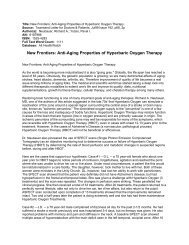Hyperbaric oxygen therapy for calcific uremic arteriolopathy: a case ...
Hyperbaric oxygen therapy for calcific uremic arteriolopathy: a case ...
Hyperbaric oxygen therapy for calcific uremic arteriolopathy: a case ...
Create successful ePaper yourself
Turn your PDF publications into a flip-book with our unique Google optimized e-Paper software.
1: J Nephrol. 2002 Nov-Dec;15(6):676-80.<br />
<strong>Hyperbaric</strong> <strong>oxygen</strong> <strong>therapy</strong> <strong>for</strong> <strong>calcific</strong> <strong>uremic</strong> <strong>arteriolopathy</strong>: a <strong>case</strong><br />
series.<br />
Basile C, Montanaro A, Masi M, Pati G, De Maio P, Gismondi A.<br />
Division of Nephrology, Hospital of Martina Franca, Italy.<br />
nefromartina@topvideo.net<br />
Calcific <strong>uremic</strong> <strong>arteriolopathy</strong> (CUA), also referred to as calciphylaxis, is a syndrome of<br />
small vessel <strong>calcific</strong>ation of unknown etiology causing painful violaceous skin lesions<br />
that progress to non-healing ulcers and gangrene. It is observed mainly in patients with<br />
end-stage renal disease, is associated with high morbidity and mortality and has no<br />
standard treatment at the present time. Although parathyroidectomy (PTX) has been<br />
advocated in some <strong>case</strong>s, other studies have not found this effective. <strong>Hyperbaric</strong> <strong>oxygen</strong><br />
<strong>therapy</strong> (HOT) consists of breathing 100% O2 at higher than ambient pressure, with the<br />
patient inside a sealed chamber. HOT has been used with some success in the treatment<br />
of selected problem wounds (those that fail to respond to established medical and surgical<br />
management). They are often severely hypoxic; restoration of tissue PO2 to normal or<br />
above-normal enhances fibroblast proliferation and collagen production as well as<br />
angiogenesis. The present is the largest retrospective <strong>case</strong> series of CUA treated by<br />
means of HOT reported so far and comprises 11 chronic <strong>uremic</strong> patients on dialysis (9<br />
hemo- and 2 peritoneal dialysis, 6 females and 5 males, mean age 56 +/- 7 SD years, time<br />
on dialysis 163 +/- 84 SD months). Four patients had biopsy-proven CUA; 3 had diabetic<br />
nephropathy as a cause of uremia; 2 were obese and 3 had a consistent increase of serum<br />
calcium x phosphorus product; 3 patients had severe secondary hyperparathyroidism<br />
(II(nd) HPTH) and two had been submitted to subtotal PTX some years be<strong>for</strong>e CUA; two<br />
others had already had the limb amputated. Lesions were in the legs, except <strong>for</strong> one in a<br />
hand, and were prevalently ulcers and necrosis. The number of sessions in each HOT<br />
cycle ranged from a minimum of 20 to a maximum of 108 (mean 40.6 +/- 29.0). The<br />
results of two therapies cannot be evaluated (one was interrupted by the patient after 10<br />
sessions, and one ended with the death of the patient due to ventricular arrhythmia after<br />
eight sessions). Eight of the nine remaining had excellent results with healing of the skin<br />
ulcers, but the ninth got worse, making it advisable to amputate the foot. In conclusion,<br />
CUA appears to result from a multitude of predisposing and/or sensitizing events that are<br />
commonly present in the <strong>uremic</strong> milieu. The specific factors that induce this disorder in<br />
an individual patient are not known. The present retrospective study supports a role of<br />
HOT in many <strong>case</strong>s of CUA, especially considering that, in the absence of severe II(nd)<br />
HPTH, there are very few therapeutic options.<br />
PMID: 12495283 [PubMed - indexed <strong>for</strong> MEDLINE]<br />
Related Links<br />
<strong>Hyperbaric</strong> <strong>oxygen</strong> in the treatment of calciphylaxis: a <strong>case</strong> series. [Nephrol Dial<br />
Transplant. 2001] PMID:11682664<br />
Healing of skin necrosis and regression of anticardiolipin antibodies achieved by<br />
parathyroidectomy in a dialyzed woman with <strong>calcific</strong> <strong>uremic</strong> <strong>arteriolopathy</strong>. [Croat<br />
Med J. 2001] PMID:11740855<br />
Cutaneous necrosis from <strong>calcific</strong> <strong>uremic</strong> <strong>arteriolopathy</strong>. [Am J Kidney Dis. 1998]
PMID:9740153<br />
Calciphylaxis and nonhealing wounds: the role of the vascular surgeon in a<br />
multidisciplinary treatment. [J Vasc Surg. 2003] PMID:12618682<br />
Calcific <strong>uremic</strong> <strong>arteriolopathy</strong>: advances in pathogenesis and treatment. [Semin<br />
Dial. 2007] PMID:17374090





